It’s always winter or autumn somewhere in the world, and for those who live in colder climates that means wearing special clothing and footwear to cope with challenging conditions. This is especially true for those who wish to continue to enjoy the outdoors and wilderness.
It is said, “No shoe, no horse” and this could offer the same advice for humans tackling the wintery streets in icy or snowy conditions. Shoes or boots with traction are needed and the dilemma for every hiker is to choose the best is crampons vs microspikes. Luckily for you, we are here to help. But first, a bit more on this topic.
More on The Topic
Modern developments in footwear designs and construction materials available ensure that the outdoor workers and fresh air lovers have a number of options available to enhance their winter traction.
There are three variations of footwear devices that assist hikers through winter walking conditions – crampons, microspikes and snow shoes; each of these has variations as to materials and construction. The latter is more about moving over snow so we will limit our discussion in this article to the advantages and disadvantages of microspikes vs crampons in slippery icy conditions.
Essentially, there are increasing levels of traction that can be added to the sole of footwear from minimal profiles of microspikes through to longer and sharper spikes on crampons. Of course the initial choice of footwear will reflect the conditions the wearer is planning to be moving through or working in.
A person clearing snow from a driveway will not likely be wearing rigid sole mountaineering boots, nor will a climber be wearing footwear only suitable for casual winter strolls. In that respect, not all traction devices will be designed to fit suitable footwear.
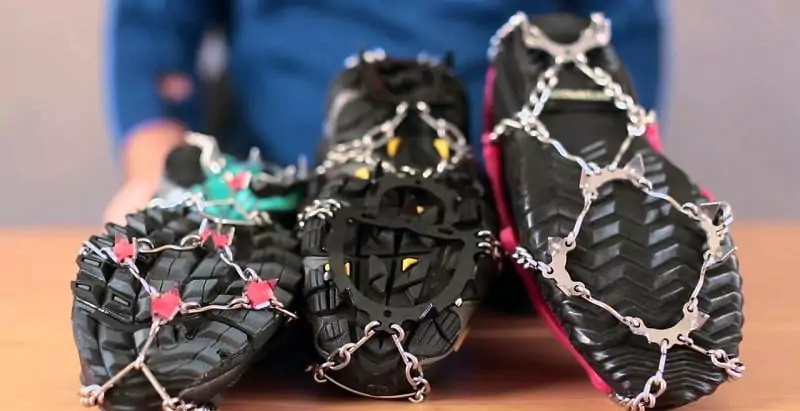
The ultimate reason for wearing these footwear traction devices is to provide stability during activities and avoid injury from slips and falls. They should give the wearer the assurance to step out with confidence so that they can place their feet securely and trust the footwear when taking a normal stride.
Footwear with trusted traction will allay fears about moving outside to get work done and enjoy life outdoors, like hiking with confidence along icy or snowy winter trails. See our article on women’s most outstanding boots for snowshoeing for your more information.
On a cautionary side, however, regardless of whether you choose microspikes or crampons, take care until you are confident and know the limits of individual traction device advantages. Not taking enough precautions can easily lead to emergencies or life threatening situations, especially in the outdoors and wilderness. Take care not to overestimate abilities or to abuse any gear beyond its intended design purposes. Take a look at our piece on how to choose the first-rate snowshoes for beginners.
Extra Traction Requires Extra Effort
Starting with the lowest gripping traction devices for footwear, there are profiles in a somewhat of a sliding scale, no pun intended, from low sole profiled coils and studs through to slightly longer profiled “nanospikes”, then “microspikes”, flexible crampons to rigid crampons and up to ice mountain climbing crampons.
They all have different pros and cons for various situations so knowledge will help you make good choices and keep you safe. The opposite can be life threatening to yourself and others.
Essentially the lower profiled devices are simple and easy to wear, while heavy duty crampons offer awesome grip in slippery conditions, but they are physically more tiresome to move with. There is no point having more traction than required if you are going to exhaust yourself unnecessarily.
Likewise crampons would be overkill and are not suitable for moving across surfaces like frozen concrete or driveways. It is quite conceivable that you will require more than a style of footwear traction device so will have microspikes and crampons for various adventures. Make sure you have the right tool for the job. Check out customer reviews for similar requirements as yours.
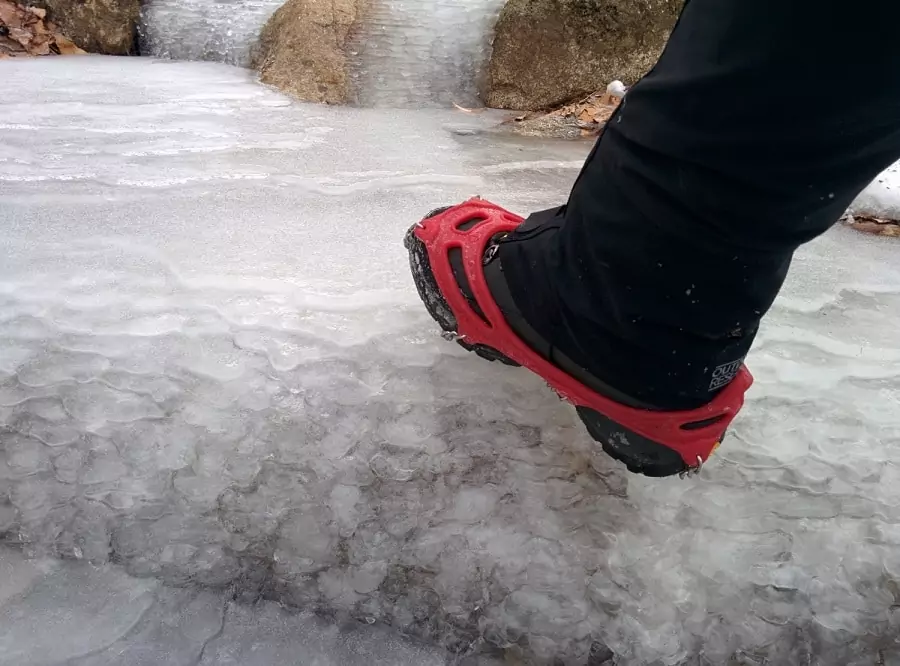
Whatever style you choose, it is also imperative that you make sure that you have the correct size for your footwear. Some styles come in multitudes of sizes for sometimes both women’s and men’s footwear shapes, shoes or boots.
There are many different attachment mechanisms, so check out how easy they are to attach and remove and how well they adjust to fit the footwear and remain in place while walking or running.
One feature that is difficult to check without use is the propensity for snow or ice buildup in the device. Some have special construction to continually resist or repel ice buildup so check reviews for this aspect. Clogging ice or snow will make the device less effective and add weight to every step.
Choose The Right Traction Device for The Job
“Microspikes” is actually a trademarked name for lesser spiked traction devices, but has now become to fit a universal term for similar lower traction devices for footwear.
The category of “microspikes” covers a relatively broad spectrum of devices available -from those with low profiles of metal chains, and coils only suitable for icy city walkways, then to “nanogrip” tungsten carbide cleats, through to longer “microspikes” with spikes up to 3/8 inches.
A minor detail perhaps, but if backpacking is on the cards, consider a system that allows for optimum packing and low weight if that is important. Could also be a factor if you have to carry them around inside, but wear them to get to and fro between home and work.
Low Profile
If your limit of use outdoors is walking along icy pavements, shoveling snow off driveways and similar situations, then there are some inexpensive tried and true options available. Yaktrax is one of the oldest established companies producing tried and true minimal, but effective systems that are inexpensive and suitable for city use.
They are lightweight, made from spike less abrasion resistant steel coils. Another spike less version has diamond shaped steel alloy beads that swivel to avoid snow and ice buildup.
This system is strapped under the footwear sole and offers more grip than metal coils. Both of these lower profile options are more comfortable to wear than spiked devices on hard surfaces like concrete or footpaths.
Nanospikes
If you are venturing out for easy hiking, ice fishing, sledding, outdoor work, or require added safety on icy roads or driveways the next level might be called “nanospikes” although this is also a trademarked name.
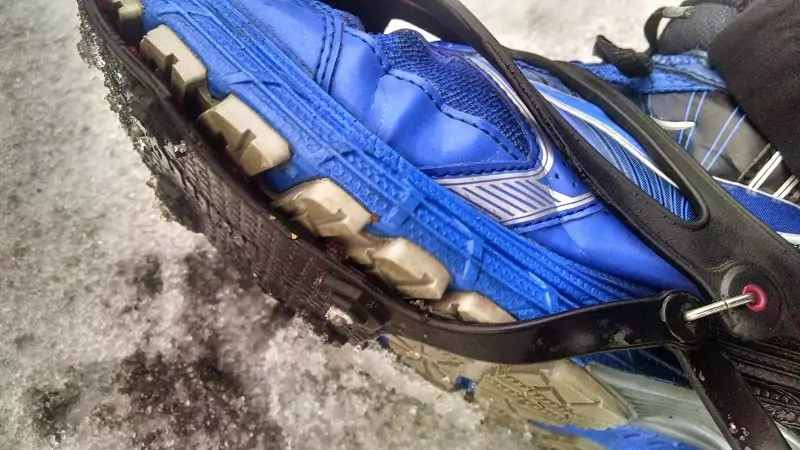
These are good general purpose traction devices, but not suited for tricky winter conditions, nor are they suitable for wearing while driving vehicles. This slightly higher level of traction is achieved by small cleats/studs/ metal loops fitted into flexible plates of various materials worn under the footwear to offer grip in snow and ice.
These grips can be of different materials including hard wearing tungsten carbide or other metals with various configurations available like multi directional steel cleats, metal loops, and so on rather like snow tires have different threads. Upward facing cleats can interface with the shoe sole to hold the device firmly in place.
Microspikes
If you are more likely to be heading off city streets, hiking up winter trails, then you will be better wearing longer spiked “microspikes”.
The longer protruding levels of traction from cleats and spikes on these are not so suited to very hard surfaces like concrete or roads, but their low level spikes offer enough stability in most track situations.
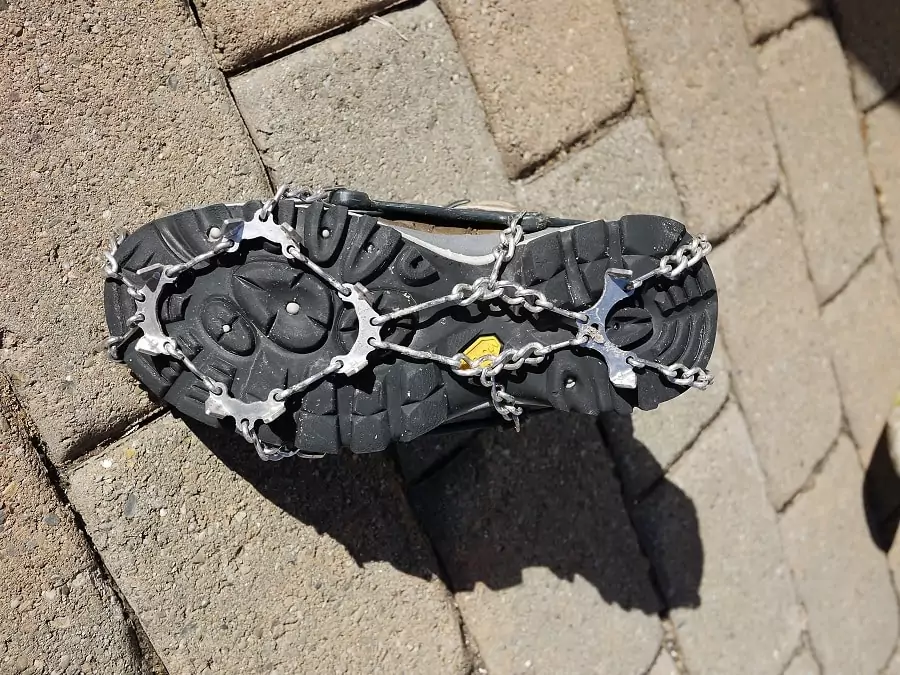
They are eminently suitable for walking, hiking, backpacking, trail running, and adventure racing in wintery conditions. Microspikes are flexible and fitted over running shoes or boots as needed.
There are even models suitable for winter marathon racing, orienteering, and other similar running events where a competitor will prefer to wear suitable comfortable trail running shoes. Microspikes are more suitable than crampons on certain winter terrains, especially when not very steep or deep in ice as movement is easier and less tiring.
Aspects to look out for when choosing microspikes are the amount and layout of the spikes, the durability of the metal used and the fit and adjustment of the upper attachment.
Crampons
Crampons are the highest level in footwear traction devices and are required for more aggressive hiking and steep icy terrain. Crampons have much longer spikes that penetrate through ice surfaces facilitating much more secure footholds than any microspike can offer.
Ultimately they are foot-gear for moving safely across glaciers, rock and ice as well as steep snow slopes, ice walls and general mountaineering. Crampons make it possible to traverse and climb in certain terrains that would otherwise be dangerous and life threatening to attempt.
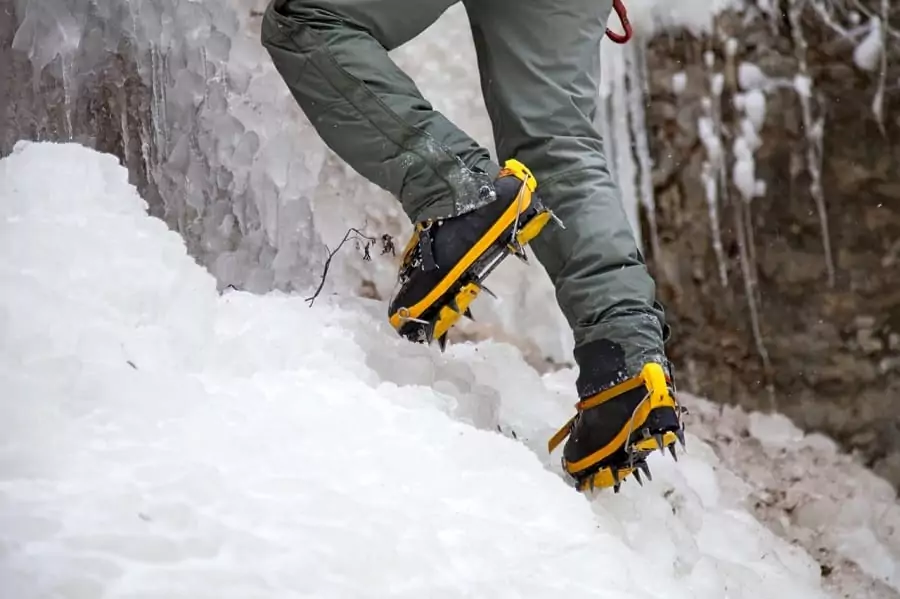
Skill is also required as crampons are sharp and require practice and experience to wear safely. They can be dangerous as, should the wearer slip or stumble, crampons can inflict serious wounds in difficult situations.
Depending on where you will be doing most of your activities determines what type of footwear you choose to wear and crampons are designed in a corresponding range of styles– for instance hiking crampons, mountain crampons, and ice fall crampons.
The general rule of thumb to follow when considering boot style is that the steeper the more challenging the terrain the stiffer the boot sole should be, likewise the crampon.
Features to look for include the composition and strength of the metal used of the spikes, the method of attachment to the boots, and the number of points and their configuration. Steel crampons are better for longevity as opposed to aluminum, which is more likely to lose effectiveness, however the latter is lighter.
As with less aggressive traction devices consider the crampon that allows as much natural stride and flexion as possible, but that also provides the grip you need for confidence. The longer the spikes, the more tiring the system can be.
Crampons can be flexible or rigid, more commonly the latter as they were originally designed for climbing and mountaineering. However with more demand now for alpine adventure racing there is an increasing demand for crampons that can be fitted to flexible soled boots for faster moving.
A crampon that can add traction, flex, maintain strength and remain attached to the boot is a huge benefit to a competitor and therefore highly sought after. Instep crampons are still available, however very few experienced hikers or winter climbers actually recommend using them.
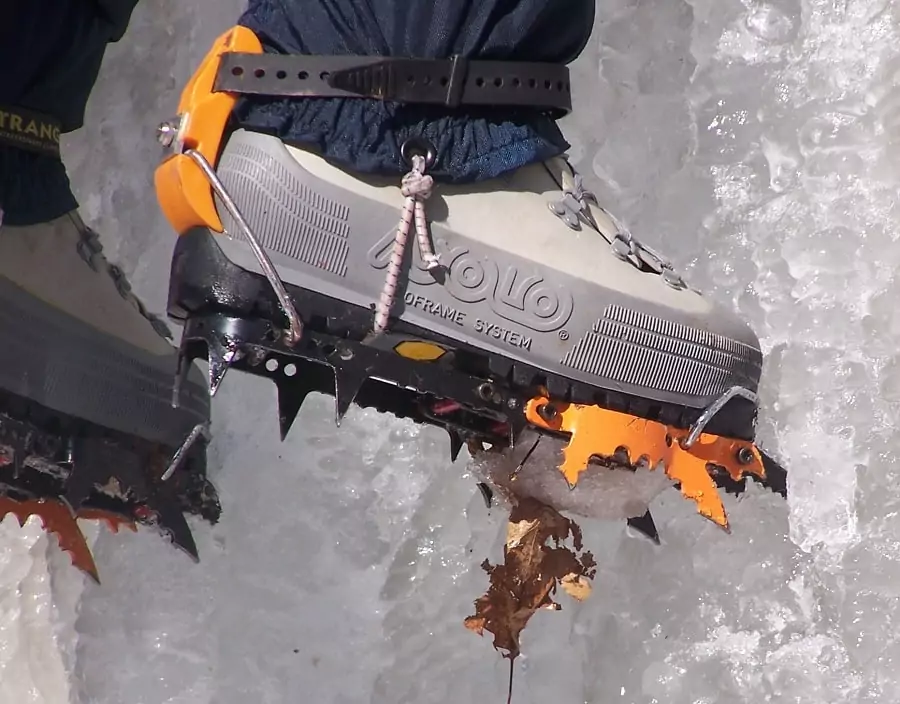
Crampons attach to boots by a few different methods. One style is with synthetic nylon or plastic straps that secure the crampons around the toe and the heel which allow a high level of adjustment so crampons can be inter changed between boots – offering a change for differing terrain, weather, and temperature.
However, these attachments are less secure in general and more likely to fall off than the other styles. This style of crampons may need re-tightening every couple of miles to remain secure.
Alternative secure fastenings are “Newmatic” style that has a toe bail/cup and a lever for tightening the heel welt and these are good for many boot styles. They are also quick to fit and remove but they do need to be fitted to each particular boot style.
For rugged ice climbing and mountaineering, boots will be rigid with specific sole styles so fit crampons that lock onto specialized boot toes and heel welts. These provide a very secure connection as opposed to strap attachments.
Crampons with 8-10 points are usually adequate for winter basic climbing and “peak bagging” so long as the climbs are not too steep or icy – equivalent perhaps to climbing up a black skiing run. For more difficult underfoot conditions like a glacier, water ice, or névé, 12-14 point crampons are required for optimum safety.
Can’t Decide? Then get More than One
So in conclusion one should not really consider Crampons vs Microspikes. Each footwear traction device offers pros and cons for different levels of terrain and changing conditions and there is more than one style for each profile level.
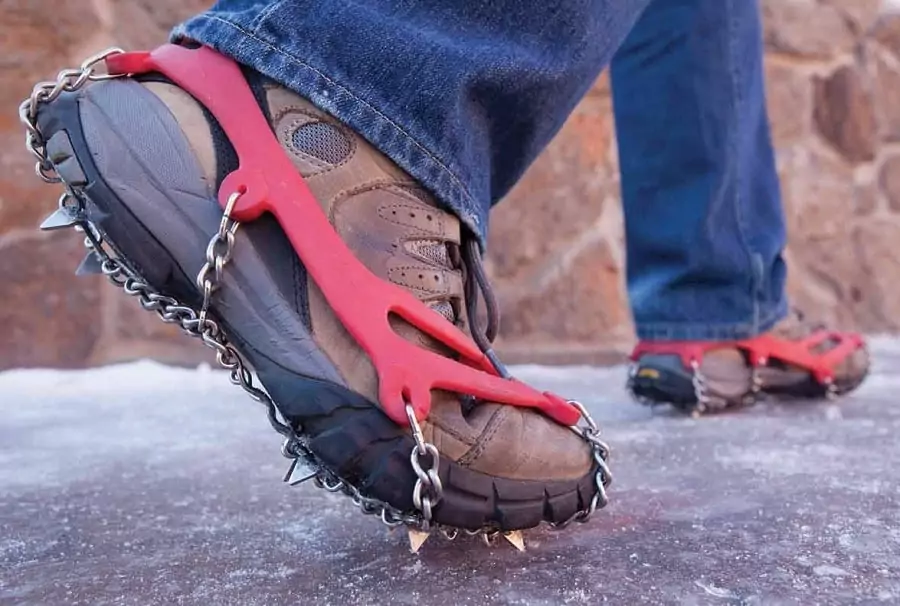
Every user should consider exactly where they wish to use the traction device, what footwear they will wear and what their own personal needs are. It is quite conceivable that a person who wishes to spend a lot of time in the winter outdoors should consider purchasing a number of different options for footwear traction device, at least one from a microspike level and one or two of different crampons.
Here’s what our experts say on how to choose the choicest snowshoes, do check it out.
So, now that you are equipped with the needed knowledge and you can make the right decision, we hope that you will leave some questions, if you have any, in the comments section below, or perhaps share some of your experiences with us.

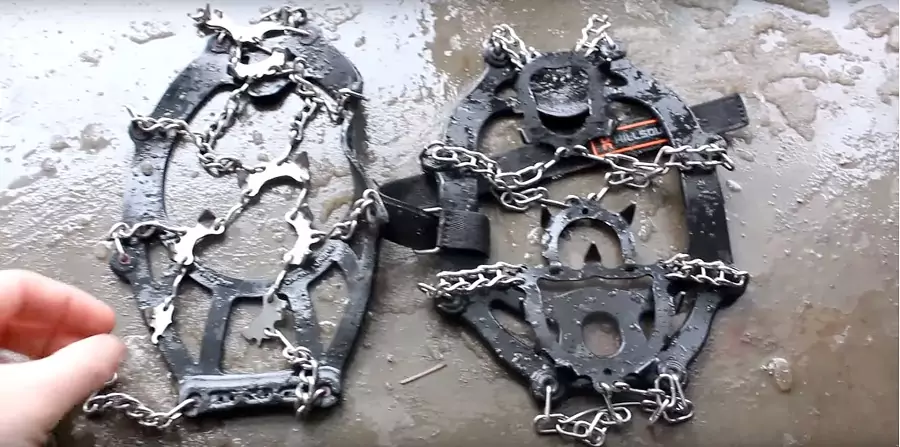
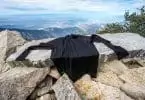



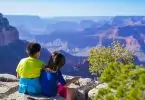

I have only been backpacking during the warm weather. I have a few health challenges that have kept me away from the winter trail and I have always envied those who hiked in the snow. Anyway, I am making final packing for my first winter trek and I had only bought crampons but I am not sure how deep the snow will be. Should I get microspikes too to be on a safe side?
Crampons are fine for steep and icy terrains and they can help you get a better grip on the snow than microspikes. These crampons have longer spikes that enable you to walk on any slippery ice surface.
Can you recommend a trusted brand for crampons? I bought some last year but their performance was very disappointing. They had very poor traction. Most of the time it felt like I was wearing just my boots. Anyway, I need to get some new ones but from a trusted brand this time.
Petzl Irvis, Black Diamond, Hillsound Trail Pro and the Grivel G10, among others are good brands of crampons that you may wish to examine. Take particular attention to the weight, anti- balling plates and materials of the products you wish to buy.
what about the driveway or hiking ? you don’t crampons…what do safety personnel use? like the guys that have to be out on an icy street while fixing your water line break or average city worker who has to be out in the ice? are crampons RIGID ? now ask this. if not rigid how effective are they? can you really have a normal gait on ice with protruding spikes at the bottom that destabilize you as you walk without twisting your ankle ? and if the foot is rigid….are you going to tire quickly. I bought something called stable ICERS …they are rigid and have hexagonal metal taps, can be brass to prevent spark fires for oil and gas transport or regular stainless steel. I haven’t tried them yet….the other thing I got was a new nano rubber made by Vibram….called arctic ice…..I haven’t tried it yet…I bought them from CAT shoes but a few other vendors like Wolverine and LL Bean have them. basically when the temp gets to freezing the nanotech material grips the ice. you can stick an ice cube on the shoe and tilt it and the ice won’t slide off…and your foot flexes…if this stuff works it will be a miracle material .